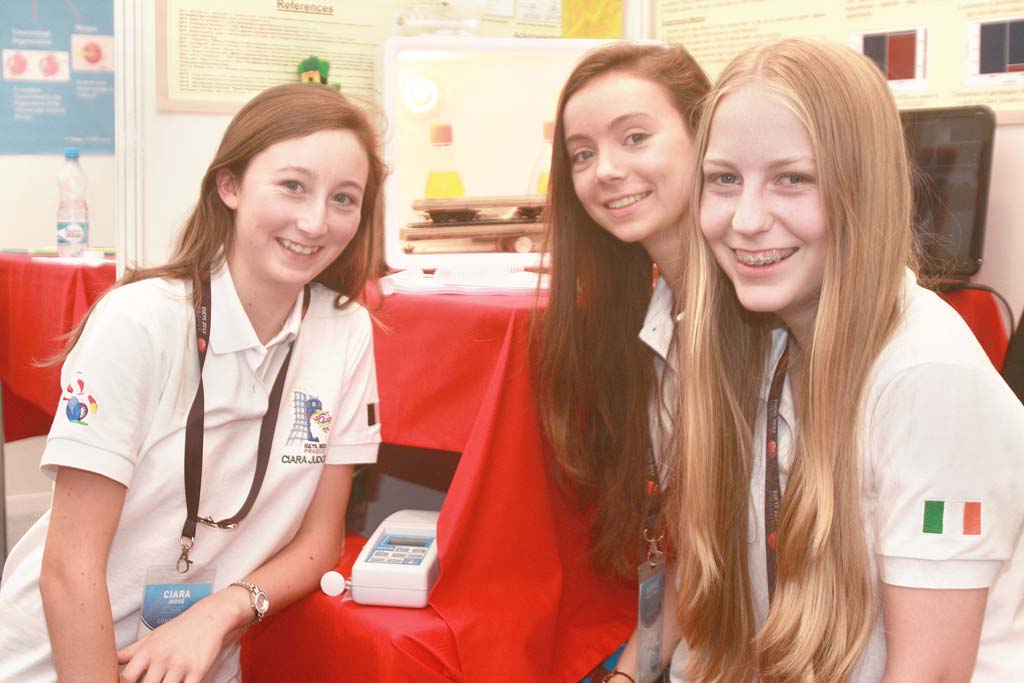Winner Google Science
Three Girls Won The Google Science Fair With A Bacteria-Based Plan To Solve The Food Crisis.
Three young girls won the Google science fair on September 22 with their innovative way to feed the world: treat plants with bacteria to help farmers grow more food, faster — without genetic modification.
“By the year 2050 we actually need 50 percent more food just to feed everyone,”Emer Hickey, one of the three winners, told Scientific American.
Hickey worked with her classmates Ciara Judge and Sophie Healy on their project. The three teenage girls, who live in Ireland, were simultaneously learning about plants and world hunger. Their project “Combating the global food crisis: Diazotroph Bacteria As a Cereal Crop Growth Promoter” aims to tackle issues of world hunger by exploiting a curious relationship they found between bacteria and certain plants.
Beneficial bacteria
After 11 months of hard work and dedication, the three teen microbiologists discovered that they could make crops yield more food and shorten the time it takes a plant to sprout from a seed — a process called germination. They shorten this time by infecting the crops with a bit of bacteria that’s been known to be advantageous to other crop plants.
Their results have huge implications for increasing agricultural productivity and easing world hunger.
The key to their success is a type of bacteria called rhizobia, which lives inside nodules, or the little nubs you sometimes see on plant roots. While we usually think of bacteria as dangerous, these are actually helpful to the plants. By converting nitrogen from the air into helpful compounds like ammonia, the bacteria aid plant growth.
Hickey and her mother had found these nodules on the pea plants in their garden. Not understanding what they were, Hickey brought one of the plants to her science teacher, who told her their benefits to plant growth.
These nodules are only found on certain plants including peas and beans. But the girls wondered, why wouldn’t these bacteria be beneficial to other species? — specifically grains like barley and oats, which are integral to our food supply.
It turns out no one had studied what the bacteria might do for non-legume plants, particularly during stages of germination. So, the girls went to work.
A root-hacking plan
They attacked their work with meticulous detail. Using homemade equipment, they chose to test rhizobia’s affects on barley and oat seeds. In order to do this, the girls had to grow the bacteria and then infuse them into the seeds, which took many hours of preparation.
After prepping the seeds, they incubated the seeds and checked them every six hours to measure how long it took germination to take place.
Before conducting a large-scale growing trial, they covered their bases and completed a small-scale trial where in the plants grew for only two weeks before harvesting.
The success of the small-scale trial gave way to a larger trial. For that, the girls grew the plants in boxes in Judge’s backyard garden for six weeks.
Once the crops had grown for six weeks, the girls harvested the plants, dried them, and weighed them to determine overall crop yield.
They repeated these steps over 11 months, tested more than 10,000 seeds, and recorded more than 120,000 individual measurements. When they were finished, they discovered that by infusing their seeds with rhizobia bacteria, the plants germinated in half the amount of time compared to seeds without rhizobia. Moreover, they measured that the mass of the plants increased by as much as 70 percent.
An agricultural enterprise
In 2011, the award-winning teens first became aware of the deep impact that a lack of food can have on the world. The Horn of Africa famine in 2011 threatened livelihoods of nearly 10 million people in East Africa countries like Somalia, Ethiopia, and Kenya.
“The idea for our project was inspired by this problem and our desire to make a difference,” they state in an outline of their Google Science Fair project.

Sophie Healy-Thow, Ciara Judge and Emer Hickey were also awarded winners of European Union Contest for Young Scientists in 2013 for using natural bacteria to speed up the germination and subsequent growth of cereal crops.
Winning the grand prize of Google’s fourth annual science fair is just another step forward for the girls. Next, they plan to better understand their results by investigating why the rhizobium bacteria they tested leads to higher crop yields and faster germination rates.
All three are currently considering careers in the biological sciences, and the scholarships they earned through Google’s Science Fair will certainly come in handy when they enter college within the next few years.
Their Google science fair triumph got them each a $50,000 college scholarship, a 10-day trip to the Galapagos Islands through National Geographic Expeditions, and a $10,000 grant for school.
Source: Jessice Orwig / businessinsider.com
The project’s research, method, data, etc can be found here : http://goo.gl/LnNs43
===================================
Hard work. The experiments.
Google Science Fair Award 2014 – Award Ceremony



